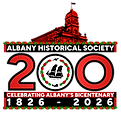Home / Celebrate 2026 Albany
Honouring and celebrating our community and the people who contributed to the first settlement of Western Australia.
In 2026 Albany will host Western Australia's first Bicentenary and the Albany Historical Society is proud to mark this profound milestone: 200 years in the making. Albany’s 2026 Bicentenary celebrates the founding of Western Australia’s first European and Aboriginal settlement. From 1826 to 2026, Albany/Kinjarling has grown, thrived and built a legacy worth honouring.
As the state’s first settlement, Albany’s 200th anniversary is more than a historical marker—it is a celebration of heritage, culture and community. Through exhibitions, events and storytelling, we look forward to honouring our unique past and inspiring the future.
The Albany Historical Society acknowledges the rich cultural heritage of this region and the deep connection of the Menang Noongar people to this land. We honour their enduring relationship with Country and the significance of Kinjarling in their lives.


The story begins with the Menang People — the Traditional Custodians of Kinjarling.
Albany, known to the Menang people as Kinjarling – “the place of rain”, lies within the traditional lands of the Menang Noongar people. The Menang people are the Traditional Custodians of this region and have maintained a deep connection to Country for countless generations.
Their culture, language and knowledge are woven into the landscape from the coastline to the hinterlands and beyond. We recognise that our shared history began long before European settlement. The strength, resilience and wisdom of the Menang people continue to shape the identity and future of our community today. We honour their enduring spiritual and cultural connection to Kinjarling and pay our respects to Elders past and present.

Robert Dale’s Panoramic View of King George Sound – On Display at the Albany Convict Gaol for the Albany 2026 Bicentenary.
As part of the Albany 2026 Bicentenary, the Albany Convict Gaol will have on display a enlarged reproduction of Robert Dale’s iconic “Panoramic View of King George’s Sound”. Ensign (later Lieutenant) Robert Dale created this remarkable panorama during his time at King George Sound in 1832. While Dale’s original work captured the landscape in intricate detail, it was Robert Havell Jr., a London engraver, who published the complete eight panel panorama in October 1834. Hand coloured and meticulously detailed, the panorama reveals a sweeping view from the summit of Mount Clarence, offering a rare glimpse into everyday life in Albany during the 1830s.
The enlarged reproduction will be displayed at the Albany Convict Gaol on Stirling Terrace in 2026 . Visitors can explore the detailed diorama of the early settlement, providing a complimentary and vivid window into Albany’s past, the traditional custodians, the Menang people and its place in Western Australia’s early history.


King George Sound Diorama: Revitalising a historic icon for Albany’s Bicentenary.
The Albany Convict Gaol Museum has long displayed a model of Major Edmund Lockyer’s 1826 settlement at King George Sound, one of the earliest visual records of European arrival in Western Australia.
As part of Albany’s 2026 Bicentenary, this iconic diorama is being fully redeveloped by local artist Matt, who is blending skilled craftsmanship with a richer, more inclusive perspective. The updated display will feature new huts, lifelike figures, and—importantly—representations of the Menang People, the Traditional Custodians of Kinjarling.
Set to become a centrepiece of Celebrate 2026: A Journey to 200 Years, the revitalised diorama will stand as a powerful tribute to the enduring history and shared heritage of King George Sound.








%20P2015_09.jpg)


_edited.jpg)
_edited.jpg)
.png)